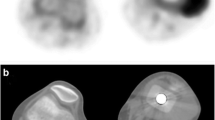Abstract
Objective. The objective of this study was to evaluate the postoperative technetium-99m-labeled methylene diphosphonate (99mTc-MDP) scintigraphic appearance of limb-sparing procedures in patients treated for bone tumors.Materials and methods. We retrospectively reviewed the medical records and assessed planar bone scans, subjectively and semiquantitatively, of all patients treated with limb-sparing procedures at our institution who survived at least 1 year following resection of the primary lesion.Results. The operative sites of 20 of the evaluable 45 patients (44 %) demonstrated normal tracer avidity during follow-up (median 12 months). Nine patients (20 %) demonstrated normal avidity on their first follow-up bone scans (median 6 months). Coincident99mTc-MDP bone scans were obtained on 11 patients who developed 12 postoperative complications or injury during the study and accurately identified the lesion in eight (67 %).Conclusion. Although many patients have abnormal99mTc-MDP avidity in the operative site after limb-sparing surgery, almost half eventually have normalization of uptake. However, planar bone scans have limited use for assessing the primary tumor site postoperatively as persistent abnormal avidity may preclude detection of changes associated with development of postoperative complications.
Similar content being viewed by others
References
Horowitz ME, DeLaney TF, Malawar MM, Tsokos MG (1993) Ewing's sarcoma family of tumors: Ewing's sarcoma of bone and soft tissue and the peripheral primitive neuroectodermal tumors. In: Pizzo PA, Poplack DG (eds) Principles and practice of pediatric oncology, 2nd edn. Lippincott, Philadelphia, pp 795–821
Robinson L (1993) General principles of the epidemiology of childhood cancer. In: Pizzo PA, Poplack DG (eds) Principles and practice of pediatric oncology, 2nd edn. Lippincott, Philadelphia, pp 3–27
Link MP, Eilber F (1993) Osteosarcoma. In: Pizzo PA, Poplack DG (eds) Principles and practice of pediatric oncology. 2nd edn. Lippincott, Philadelphia, pp 841–866
Kaste SC, Rao BN, Lynch MIL, Parham DM, Meyer WH (1996) Multifocal osteolysis following limb-sparing procedures: imaging findings and review of the literature. Pediatr Radiol 26:128–161
Utz JA, Lull RJ, Galvin EG (1986) Asymptomatic total hip prosthesis: natural history determined using Tc-99m MDP bone scans. Radiology 161:509–512
Duus BR, Boeckstyns M, Kjaer L, Stadeager C (1987) Radionuclide scanning after total knee replacement: correlation with pain and radiolucent lines. A prospective study. Invest Radiol 22:891–894
Yamamura S, Sato K, Sugiura H, Nakanishi K, Iwata H (1995) Moderate heat-treated autogenous bone grafts. International Symposium on Limb Salvage, May 10–12,1995, Florence, Italy, 23 (abstract)
Author information
Authors and Affiliations
Rights and permissions
About this article
Cite this article
Kaste, S.C., Rao, B.N., Meyer, W.M. et al. Limb-sparing procedures: postoperative planar bone scan appearance. Pediatr Radiol 26, 750–753 (1996). https://doi.org/10.1007/BF01383399
Received:
Accepted:
Issue Date:
DOI: https://doi.org/10.1007/BF01383399




